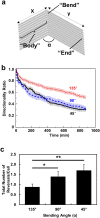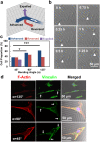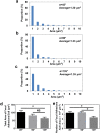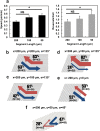A Unidirectional Cell Switching Gate by Engineering Grating Length and Bending Angle
- PMID: 26821058
- PMCID: PMC4731054
- DOI: 10.1371/journal.pone.0147801
A Unidirectional Cell Switching Gate by Engineering Grating Length and Bending Angle
Abstract
On a microgrooved substrate, cells migrate along the pattern, and at random positions, reverse their directions. Here, we demonstrate that these reversals can be controlled by introducing discontinuities to the pattern. On "V-shaped grating patterns", mouse osteogenic progenitor MC3T3-E1 cells reversed predominately at the bends and the ends. The patterns were engineered in a way that the combined effects of angle- and length-dependence could be examined in addition to their individual effects. Results show that when the bend was placed closer to one end, migration behaviour of cells depends on their direction of approach. At an obtuse bend (135°), more cells reversed when approaching from the long segment than from the short segment. But at an acute bend (45°), this relationship was reversed. Based on this anisotropic behaviour, the designed patterns effectively allowed cells to move in one direction but blocked migrations in the opposing direction. This study demonstrates that by the strategic placement of bends and ends on grating patterns, we can engineer effective unidirectional switching gates that can control the movement of adherent cells. The knowledge developed in this study could be utilised in future cell sorting or filtering platforms without the need for chemotaxis or microfluidic control.
Conflict of interest statement
Figures






Similar articles
-
Biointerfaces with ultrathin patterns for directional control of cell migration.J Nanobiotechnology. 2024 Apr 8;22(1):158. doi: 10.1186/s12951-024-02418-3. J Nanobiotechnology. 2024. PMID: 38589901 Free PMC article.
-
Control of cell migration direction by inducing cell shape asymmetry with patterned topography.J Biomed Mater Res A. 2015 Jul;103(7):2383-93. doi: 10.1002/jbm.a.35378. Epub 2014 Dec 4. J Biomed Mater Res A. 2015. PMID: 25430523
-
Effects of topographical guidance cues on osteoblast cell migration.Sci Rep. 2020 Nov 17;10(1):20003. doi: 10.1038/s41598-020-77103-0. Sci Rep. 2020. PMID: 33203986 Free PMC article.
-
Influence of engineered surface on cell directionality and motility.Biofabrication. 2014 Mar;6(1):015011. doi: 10.1088/1758-5082/6/1/015011. Epub 2014 Mar 4. Biofabrication. 2014. PMID: 24589941
-
Flux at focal adhesions: slippage clutch, mechanical gauge, or signal depot.Sci STKE. 2007 Mar 13;2007(377):pe10. doi: 10.1126/stke.3772007pe10. Sci STKE. 2007. PMID: 17356172 Review.
Cited by
-
Biointerfaces with ultrathin patterns for directional control of cell migration.J Nanobiotechnology. 2024 Apr 8;22(1):158. doi: 10.1186/s12951-024-02418-3. J Nanobiotechnology. 2024. PMID: 38589901 Free PMC article.
-
Engineered barriers regulate osteoblast cell migration in vertical direction.Sci Rep. 2022 Mar 15;12(1):4459. doi: 10.1038/s41598-022-08262-5. Sci Rep. 2022. PMID: 35292702 Free PMC article.
-
Dynamic Tracking of Osteoblastic Cell Traction Force during Guided Migration.Cell Mol Bioeng. 2017 Dec 5;11(1):11-23. doi: 10.1007/s12195-017-0514-7. eCollection 2018 Feb. Cell Mol Bioeng. 2017. PMID: 31719876 Free PMC article.
-
Cell traction force in a confined microenvironment with double-sided micropost arrays.RSC Adv. 2019 Mar 14;9(15):8575-8584. doi: 10.1039/c8ra10170a. eCollection 2019 Mar 12. RSC Adv. 2019. PMID: 35518671 Free PMC article.
-
Control of neural probe shank flexibility by fluidic pressure in embedded microchannel using PDMS/PI hybrid substrate.PLoS One. 2019 Jul 24;14(7):e0220258. doi: 10.1371/journal.pone.0220258. eCollection 2019. PLoS One. 2019. PMID: 31339963 Free PMC article.
References
-
- Palm D, Lang K, Brandt B, Zaenker KS, Entschladen F. In vitro and in vivo imaging of cell migration: two interdepending methods to unravel metastasis formation. Semin Cancer Biol. 2005;15:396–404. - PubMed
-
- Guvakova MA. Insulin-like growth factors control cell migration in health and disease, Int. J. Biochem. Cell Biol. 2007;39:890–909. - PubMed
Publication types
MeSH terms
Substances
LinkOut - more resources
Full Text Sources
Other Literature Sources

